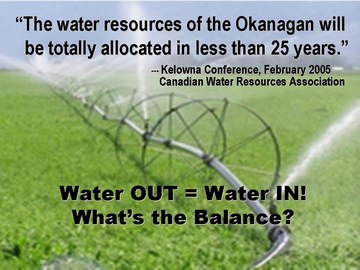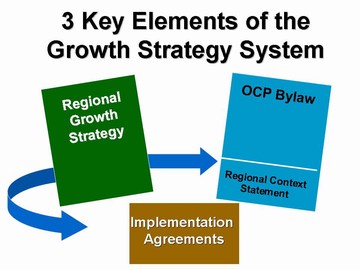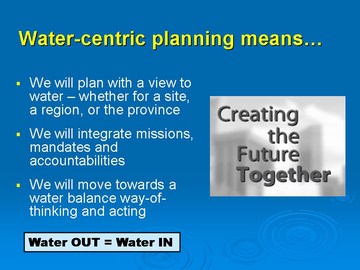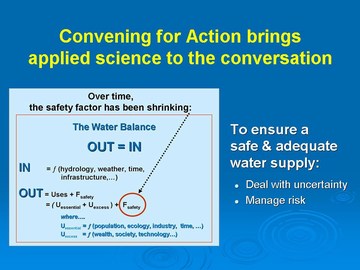South Okanagan Regional Growth Stategy

Regional District of Okanagan-Similkameen endorses moving forward with water-centric outreach program
When it met in Penticton in June 2006, the Steering Committee for the South Okanagan Regional Growth Strategy approved a set of policy statements on water management, including a motion to work with the Water Sustainability Action Plan for British Columbia to develop and implement the third phase of Convening for Action in the South Okanagan.
The Regional Growth Strategy is an initiative of the Regional District of Okanagan-Similkameen (RDOS). The Action Plan is being delivered by the Water Sustainability Committee of the BCWWA (British Columbia Water & Waste Association) through a partnership with the Province.

Regional Growth Strategy
“A regional growth strategy is the most effective way to integrate the full range of government and non-government interests in a region. It focuses on the 14 goals and objectives as identified in the Local Government Act”, stated Meggin Messenger (Manager Okanagan Growth Strategies, Ministry of Community Services). “The preparation of a regional growth strategy involves all orders of government and the public in defining vision, goal and objective statements that respond to current and anticipated land use and development issues to meet the needs of current and future residents.”
“The Implementation Agreements that will flow from the South Okanagan Regional Growth Strategy will hold the key to long-term success in achieving water sustainability”, added David Arsenault, RDOS Regional Growth Strategy Coordinator, “The Implementation Agreements will define what local governments will actually do on-the-ground to change policies, programs and practices that influence how land is developed and water is used.”
To Learn More:
For more information, click on Mid-Strategy Overview prepared for the RDOS Growth Strategy Steering Committee

Convening for Action in the South Okanagan
At the June meeting, representatives of the Province and the Water Sustainability Committee provided the elected officials with a briefing on what Convening for  Action has accomplished to date in the South Okanagan. Kim Stephens, Program Coordinator for implementation of the Action Plan, informed the Steering Committee that “In convening for action at a regional scale, we build capacity through a 3-step process that poses these defining questions:
Action has accomplished to date in the South Okanagan. Kim Stephens, Program Coordinator for implementation of the Action Plan, informed the Steering Committee that “In convening for action at a regional scale, we build capacity through a 3-step process that poses these defining questions:
- Vision:What do you want this place to look like in 20 years, 50years?
- Starting Point:What are you doing to achieve this?
- Strategy: What are you going to do better or differently to get from here to there?
Everything is connected, and how we develop land determines how water is used and how water runs off the land. Because water has been identified as the #1 concern of the public, the South Okanagan Regional Growth Strategy will serve as a provincial pilot for advancing the water balance way-of-thinking and acting.”
To Learn More:
To download a copy of the presentation to the Steering Committee, click on this link: Regional Growth Strategy: Moving towards a Water Balance Way-of-Thinking and Acting in the South Okanagan

Convening for Action in the South Okanagan was initiated in October 2005. The Real Estate Foundation seeded the first phase. The Ministry of Environment has funded the current phase. According to David Arsenault, “The next phase will be a water-centric outreach and continuing education program sponsored by the RDOS to build regional capacity and understanding of what Water OUT = Water IN means in the context of the Regional Growth Strategy and its goals. Our first step will be to apply to the Okanagan Water Stewardship Council for a grant because our local efforts will help to inform a basin-wide strategy.”

Arsenault noted that in May the Stewardship Council was briefed regarding Convening for Action when Kim Stephens delivered a presentation titled The ACTION in Convening for Action: Water-Centric Planning in the South Okanagan. A key message in his presentation was the opportunity the Council has to facilitate a plan-of-action for the entire Okanagan by leveraging the case study precedent that is currently being established in the South Okanagan. According to Stephens, “Water-centric planning means that we will plan with a view to water – whether for a site, a region, or the province.”

Water for Life and Livelihoods
The Steering Committee for the South Okanagan Regional Growth Strategy also decided that it will apply the concept water for life and livelihoods to promote a water balance approach to social, economic and environment sustainability over the short and long terms. “In a nutshell, this concept explains the relationship between water use by the public for the day to day sustenance and the need for water to be a key consideration in economic activity in the region”, stated David Arsenault.
“The mind-map provided by Water for Life and Livelihoods is ‘borrowed’ from work done in the United Kingdom, where basin plans are being prepared in accordance with the European Community’s ‘water policy directive’. This directive calls on all member countries to prepare water management plans at the river basin scale to guide area and sector-based water management strategies. The phrase conveys the fundamental principles of sustainability of natural systems in their own right and in relation to the health and well-being of people who benefit from the use of water for basic life needs and economic activity”, added Kim Stephens.
A ‘mini-summit’, organized in conjunction with the BCWWA Annual Conference that was held in Whistler in May, commenced the branding process within British Columbia for use of the phrase water for life and livelihoods to focus on what is at stake over both the short and long terms. The fact the conference was a provincial forum raised the profile of the South Okanagan as a provincial pilot for water-centric planning.
To Learn More:
The communiqué arising from the mini-summit can be downloaded by clicking on this link to the Report on a Mini-Summit Dealing with Water Stewardship & Sustainability in the South Okanagan

Provincial Grant Programs and Sustainable Infrastructure
The Regional Growth Strategy and Convening for Action are working together to support implementation of sustainable infrastructure. According to Glen Brown (Director of Infrastructure and Engineering, Ministry of Municipal Services), “There is a strong linkage between effective long-term local government planning and long-term infrastructure costs. A Regional Growth Strategy that is mindful of this connection, and is effectively implemented on-the-ground, can result in long-term infrastructure cost-efficiencies plus positively influence the future form of development.”
In his part of the joint presentation to the Steering Committee, Brown elaborated on how the Regional Growth Strategy and Convening for Action are working together in four ways:
- By making the linkages between strategic vision/planning and ‘on-the-ground’ infrastructure;
- By providing ‘real-life’ examples of what the vision looks like;
- By achieving improved value regarding both capital and life-cycle costing for infrastructure investments (economic, social and environment); and
- Supporting and promoting provincial programs/objectives.
“In the case of water-centric infrastructure, the Ministry of Community Services supports innovative local government planning and is working proactively to improve the integration of long-term, strategic planning and the implementation of physical infrastructure. The Ministry foresees future grant programs may have requirements built into them that ensure that strategic and sustainable planning is integral to a successful application”, concluded Brown.

Leading by Example
In wrapping up the briefing session, Meggin Messenger pointed out that a previous motion by the Steering Committee (on May 18, 2006) had created the opportunity for the RDOS to lead by example. That motion read as follows:
“THAT the Regional Growth Strategy work with the “Convening for Action” program through the British Columbia Water and Waste Association and Okanagan Water Stewardship Council for the purpose of developing education, and best use water practices management program for water in the South Okanagan.”

“From the perspective of the Ministry of Environment, the endorsement of water-centric policy statements for inclusion in the South Okanagan Regional Growth Strategy is precedent-setting”, observed Lynn Kriwoken (Director of Planning and Innovation, Water Stewardship Division), “The RDOS and its member municipalities and rural areas have taken the first steps towards implementing a Water OUT = Water IN approach to ensuring a safe and adequate water supply. The Ministry of Environment applauds this on-the-ground leadership.”
The story of the RDOS Growth Strategy will be one of the building blocks for Water-Centric Planning: A Guidebook for British Columbia. This guidance document is a deliverable under the Water Sustainability Action Plan, and will be founded on British Columbia case study experience in implementing a water-centric approach to community planning and development.


